Averting Disaster - A Guide To Computer Backups (2014)
by Brett Howse on May 21, 2014 9:00 AM EST- Posted in
- IT Computing
- Mac
- Apple
- Windows
- Cloud Computing
- macOS
Built-in Backup Tools - OS X
Apple introduced Time Machine back with the Leopard release in 2007. Time Machine is an all-in-one built-in backup utility, allowing both file and image level backups with versioning. Time Machine will back up to internal or external disks, as well as the AirPort Time Capsule which is Apple’s own NAS specifically for backups. You can also back up to another Mac running at least Leopard, and with Mountain Lion Apple added the ability to backup to multiple destinations, with the backups alternating among the backup targets to provide additional levels of redundancy. Officially, Time Machine is not supported on other NAS devices. It does not work natively with Server Message Block (SMB) or Network File System (NFS) shares but instead requires the Apple Filing Protocol (AFP). If you are not going to use an AirPort device, ensure the NAS you select specifically supports Time Machine. Time Machine is simple to use, and yet powerful enough to be an almost complete backup solution for the Mac. Let’s look at how to set it up:
- First you need to configure a backup disk. Ensure you have your backup disk connected, or your AirPort Time Capsule configured, and then open the Time Machine menu from the menu bar by clicking the Time Machine icon and choosing Open Time Machine Preferences…
- On the Time Machine menu, click Select Backup Disk…
- Here it will display the available backup targets. Choose the backup target you’d like to use, whether it is an attached hard disk or the AirPort Time Capsule and click Use Disk. If the hard disk is not formatted with HFS+, you will be prompted to erase the disk and reformat which will of course delete any data currently on the backup target.
- Now that you’ve selected a disk, Time Machine will automatically start backing up.
Time Machine does a full backup of your system, and then it starts to back up every hour. If the backup target is unavailable it will delay the backup until it is available again. Because only changes are backed up, each successive backup is relatively quick. If you would like to exclude some files from being backed up, click the Options button in the Time Machine menu to add exclusions.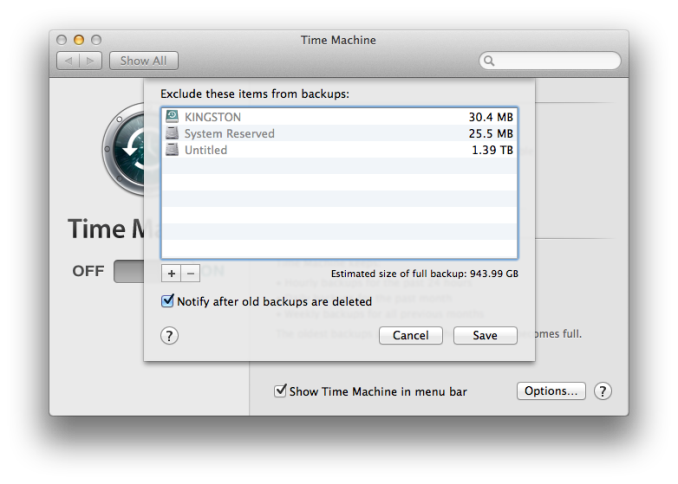
Other advanced options are not available, so there is no way to increase or decrease the frequency of backups or specify how many versions of a file to keep. The program will just back up indefinitely until it fills the available backup target, at which point it begins to delete the oldest files first.
Restoring files is relatively easy as well:
- Navigate to the folder where the file you want to recover should be (example – Documents).
- Click on the Time Machine icon in the menu bar and choose Enter Time Machine.
- This will open the restore interface, which shows a list of all of the previous backups sequentially. Using the arrows allows you to move from one backup to the next, or you can utilize the date bar on the right side which will allow you to move back to a known date. Selecting a backup date will then display the folder exactly as it was during the backup.
- Once you’ve located the file you wish to restore, select the file, and then click Restore. If the file was deleted, it will just be restored, but if the file still exists in its original location, you will be prompted to overwrite the file.
Time Machine can also be used within certain programs such as contacts, and restores operate in the same manner as files.
To restore the entire system to a previous state, hold down the Command and R keys at startup to enter the Recovery mode. In Recovery mode, one of the options is to restore from a Time Machine backup.


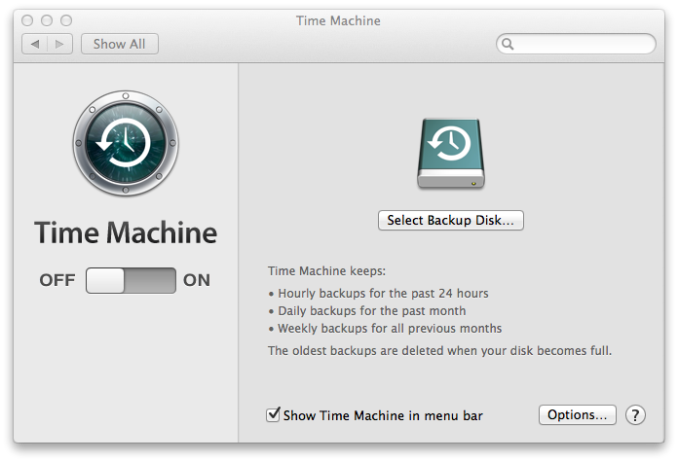
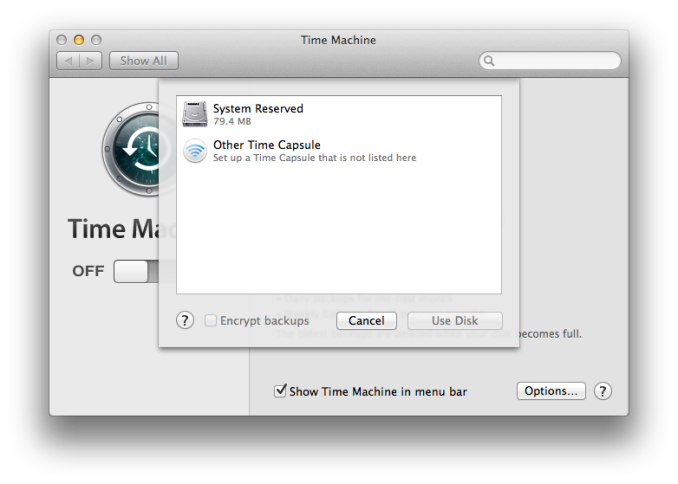
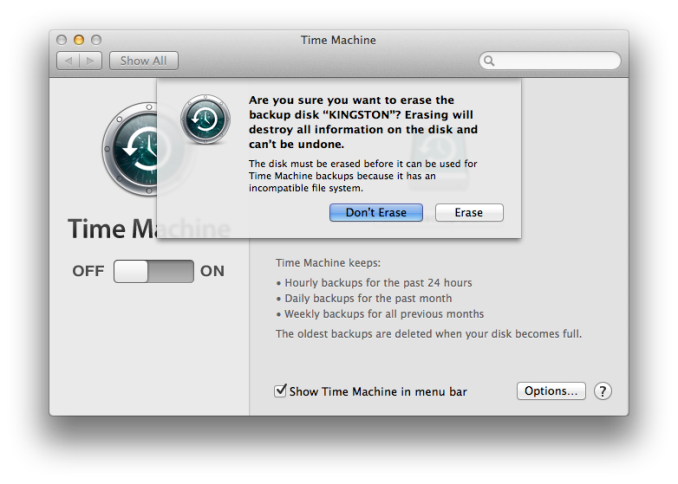






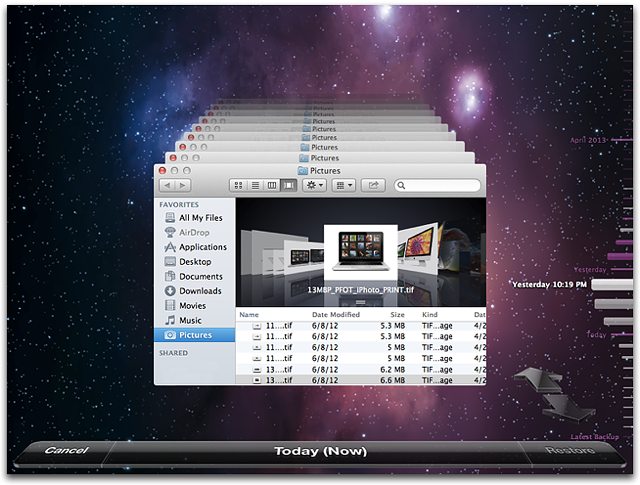








133 Comments
View All Comments
cgalyon - Wednesday, May 21, 2014 - link
Previously I used Dropbox to sync between three systems, including my file server, and then periodically do a manual backup to a dedicated backup drive. Recently this failed me for the exact reason stated early in this article: user error. After doing a restore on one of my computers, Dropbox then synced forward and wiped out one of my folders almost completely because the computer was restored to an earlier date. I didn't notice for a long time and the rollback period on Dropbox had elapsed. I would advocate a different solution or more frequent archiving.pirspilane - Wednesday, May 21, 2014 - link
Re. Windows 8.1: 'Unfortunately, you can’t add user defined folders here which you do want backed up.' True, but can't you add those folders to a library that gets backed up?peterfares - Wednesday, May 21, 2014 - link
Yes. You can also create as many libraries as you want and put whatever folders you want in them.Brett Howse - Wednesday, May 21, 2014 - link
Hi. I've updated the guide to reflect this and make it more clear. Thanks!jeffkibuule - Wednesday, May 21, 2014 - link
My system is a bit more complicated but it works for me:1) Office documents and such are stored in OneDrive.
2) OneDrive sync to my Synology NAS with BittorrentSync.
3) Time Machine Backup on my Synology NAS whenever I am home.
4) Synology NAS backup nightly to Amazon Glacier with Glacier Sync.
This provides multiple local backups as well as a cloud backup that's mostly automatic. I don't directly back up to the cloud from my MacBook Pro simply because when I am out an about, internet connection usually sucks too much to bother.
Brett Howse - Wednesday, May 21, 2014 - link
I didn't really mention Glacier, but it's easily the most cost effective cloud storage. Obviously it has it's drawbacks but price sure isn't one of them. Are you happy with Glacier?SeanFL - Friday, May 23, 2014 - link
some have found Glacier pricing difficult to figure out. I have about 100 gig in pictures that I wanted to backup but was warned on some photo forums that the per item pricing can get costly and I should zip by year or some other form so not as many individual files were transferred. Sounded like too much human interaction so I passed on Glacier inside my Synology NAS for now.dado023 - Wednesday, May 21, 2014 - link
how come nobody mentioned https://copy.com?r=uABGaD ?You get so much space, especially if you invite people to it, atm i have 62GB, and i will get more if you use link above, plus you get 5GB via referral link.
I use it for my photos, this way i deliver photos to my client via public link.
kmmatney - Wednesday, May 21, 2014 - link
I use Windows Home server, with DrivePool to duplicate data across random drives. The automatic backups work great - and it stores backups for the last 3 days, a backup from 3 weeks ago, and one from 3 months ago, for each PC in the house. it works perfectly, and I never have to think about it, and pulling out data from a backup is easy.ander111 - Wednesday, May 21, 2014 - link
Okay, let me see if I understand this clearly: A "backup" is when you copy your important data to a different storage device, so that if anything happens to your original device, you still have a copy of your data, right? And there are various ways to do this, but they all basically involve copying your data from one device to another. I think even I can understand that.Still, it's important to have articles on things like this. It keeps writers busy and off the streets—so naturally, crime goes down... Good thinking!